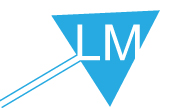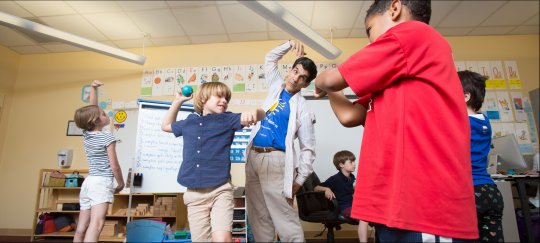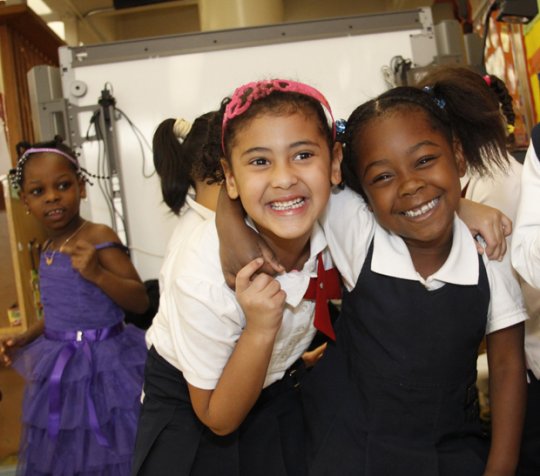Unit 4: Lesson 14
Perform & Inform
LITERACY OBJECTIVE
By the end of this lesson students will be able to reflect on their learning with an audience.
LITERACY "I CAN" STATEMENT
"I can reflect on my learning with an audience."
LESSON OVERVIEW
| Minutes |
Pacing: 60 Minutes |
|
|
60 Minutes |
Standards Alignment
Reading Standards (Informational Text)
RL 3.1: Ask and answer questions to demonstrate understanding of a text, referring explicitly to the text as the basis for the answers.
RL 3.2: Recount stories, including fables, folktales, and myths from diverse cultures; determine the central message, lesson, or moral and explain how it is conveyed through key details in the text.
RL 4.1: Refer to details and examples in a text when explaining what the text says explicitly and when drawing inferences from the text.
Speaking & Listening
SL 3.1a: Come to discussions prepared, having read or studied required material; explicitly draw on that preparation and other information known about the topic to explore ideas under discussion.
SL 3.1b: Follow agreed-upon rules for discussions (e.g., gaining the floor in respectful ways, listening to others with care, speaking one at a time about the topics and texts under discussion).
SL 3.1c: Ask questions to check understanding of information presented, stay on topic, and link their comments to the remarks of others.
SL 3.1d: Explain their own ideas and understanding in light of the discussion.
SL 3.3: Ask and answer questions about information from a speaker, offering appropriate elaboration and detail.
SL 3.6: Speak in complete sentences when appropriate to task and situation in order to provide requested detail or clarification.
SL 4.1a: Come to discussions prepared, having read or studied required material; explicitly draw on that preparation and other information known about the topic to explore ideas under discussion.
SL 4.1b: Follow agreed-upon rules for discussions and carry out assigned roles.
SL 4.1c: Pose and respond to specific questions to clarify or follow up on information, and make comments that contribute to the discussion and link to the remarks of others.
SL 4.1d: Review the key ideas expressed and explain their own ideas and understanding in light of the discussion.
SL 4.3: Identify the reasons and evidence a speaker provides to support particular points.
SL 4.6: Differentiate between contexts that call for formal English (e.g., presenting ideas) and situations where informal discourse is appropriate (e.g., small-group discussion); use formal English when appropriate to task and situation.
SL 5.1a: Come to discussions prepared, having read or studied required material; explicitly draw on that preparation and other information known about the topic to explore ideas under discussion.
SL 5.1b: Follow agreed-upon rules for discussions and carry out assigned roles.
SL 5.1c: Pose and respond to specific questions by making comments that contribute to the discussion and elaborate on the remarks of others.
SL 5.1d: Review the key ideas expressed and draw conclusions in light of information and knowledge gained from the discussions.
SL 5.3: Summarize the points a speaker makes and explain how each claim is supported by reasons and evidence.
SL 5.6: Adapt speech to a variety of contexts and tasks, using formal English when appropriate to task and situation.
Teaching Resources
-Graphic Notation Chart for each Ensemble
-Chart with Class's Central Theme for Seedfolks
-Music Instruments and Stations and Music Stand for Teacher-Conductor
Unit 4 includes the following Life & Learning Skills:
-Reflective thinking
-Creative problem-solving
-Critical and analytic thinking
-Collaboration Communication
 Differentiation Options
Differentiation Options
Differentiation Options will appear throughout the unit to suggest ways to scaffold or challenge student learning. Use the number of helping hands to select the level of differentiation that best supports student learning.


 Highest level of scaffolding. Select this option if students are learning strategies for the first time, if the text is challenging for them, or if students require more guidance during activities. Part 1 lessons are written for the highest level of scaffolding.
Highest level of scaffolding. Select this option if students are learning strategies for the first time, if the text is challenging for them, or if students require more guidance during activities. Part 1 lessons are written for the highest level of scaffolding.

 Moderate scaffolding. Select this option if students require some support comprehending the text or navigating the activity.
Moderate scaffolding. Select this option if students require some support comprehending the text or navigating the activity.

Least amount of scaffolding/Extending the instruction. Select this option if students are ready to work more independently, move more quickly through the material, or are ready for additional challenge.
 Leveraging Moments
Leveraging Moments
Key instructional steps where the arts are used to leverage literacy-learning (and vice versa) are marked with  . Smaller leveraging moments also occur throughout the lessons.
. Smaller leveraging moments also occur throughout the lessons.
Process: Give an overview of the lesson objective, which is to perform the Seedfolks Composition. Students perform for an audience and reflect on learning. Set up performance space prior to this lesson. Set up tables, if they are used for instruments, in a roughly semi-circle formation. Create a sitting area for the audience, either chairs or on the floor.
Alternatives Perform & Inform Audiences
Students could perform for many types of audiences, such as:
-Another class also studying this unit.
-This is a wonderful way for students to see the similarities and differences among Central Themes and Compositions, generated from the same Arts for Learning material. NOTE: If these classes perform for each other, it is best to follow the outline of this lesson as written. Performers will perform best if their final run-through is just prior to their performance.
-Another class (younger, buddy, grade level team)
-Whole school assembly
-Friends and family (day or night)
-Family Fun Art Night
-Expeditionary Night
Suggested Dialogue
"By the end of today's lesson, you will be able to say, 'I can reflect on my learning with an audience'."
Process: Guide ensembles to rehearse two more times through the Seedfolks Composition. If it has been several days since your last lesson, you may wish to give each ensemble three minutes to review their theme and Graphic Notation Charts prior to rehearsing the entire Seedfolks Composition. It is best if the instruments can put in place (on a table or floor) before the audience comes in. Choose whether the musicians will be standing in place (instruments resting on the table or on the floor) as audience is coming in, or if they will walking into the performance space just before the presentation begins. Whatever the choice, have ensembles practice from the point that the audience starts coming in, through the entire piece and the bowing sequence, without stopping. Remind students that as performers, we do our best. If mistakes happen, ignore them and move on. Make a quick check after the first run-through - are people watching? Does timing need to be corrected? Then run through once more.
Teaching Tip: Conducting Cues
General Guidelines: Use large, firm hand gestures. Think ahead and anticipate entrances. Make eye contact with at least one musician in the ensemble about to play. This will usually be the natural leader of the group, or the first person who plays.
"Get Ready" & "Go" Signals: To get students ready to play their theme, make an initial "backwards J" movement. This helps musicians anticipate their entrance. Signal ensembles to begin playing their themes by making a straight downward motion. The two movements flow smoothly without stopping. Tell students to come in when your hand returns to the lowest level. When first practicing these signals with students, it is helpful to include the verbal cues, "And . . . now." Say, "And . . ." as the hand is moving upwards; say, "Now" when the hand returns to its starting position.
"Bow" cue: Hold hand up in the air. When all students are watching, silently use fingers to count "one, two, three." On beat four, open palm and arm makes downwards motion as conductor bows. Students bow with conductor. To practice with verbal aid, say, "One, two, three, bow . . ."
Suggested Dialogue
"For our final rehearsal, we will practice our performing skills. We will learn how we will be as the audience enters, and how to bow."
Entering the performance space prior to the arrival of the audience
"We are officially performers once the audience enters the room. We maintain this attitude until the audience has left. What do you think would look bad to the audience? (Students may respond: Talking, goofing off.) What attitude would impress our audience?" (Students may respond: Standing quietly, keeping instruments quiet.).
If entering the performance space after the audience arrives
"Once the audience has been seated, we will walk into the performance space. Our instruments will be in place (State where: on the tables or on the floor.) OR, Once the audience has been seated, we will walk into the performance space holding our instruments. I'll show you how you'll enter. When I play the "Go" signal, please take your positions in the semi-circle for our performance. (Play "Go" signal. Ensembles move into position.) When I play the "Go" signal, you will exit the performance area single file and stay in a single file line when you exit the space. (Play "Go" signal. Ensembles exit space into hallway or behind curtain.) The first person who will enter the performance space is the last person who just exited. This is the order your will enter. When I play the "Go" signal, enter the performance area single file." (Play "Go" signal. Ensembles enter the performance space.)
Taking a bow at the end of the performance:
"At the end of our Seedfolks Composition, we will take a bow. I will cue you to bow at the same time by holding my hand up in the air, silently counting 1-2-3 with my fingers, and on 4, I will open my palm and my arm will make a downward motion and we'll all bow together. Like this. (Demonstrate bow.) Let's practice. Ready..." (Practice taking a bow.)
Seedfolks Ensembles rehearse individual themes, if needed
"You have five minutes to rehearse your themes. Then we'll run through the composition a couple times." (Ensembles rehearse.)
Run through Seedfolks Composition
"We have time to run-through our Seedfolks Composition two times before our audience arrives. Does anyone need to give an instrument to another musician? How will you do it, and when?" (Students respond.)
"To start, one student will read the Central Theme. (Assign reader.) A spokesperson from each ensemble will briefly explain what character traits or transition you have represented in the music. For the Seedfolks Theme, a spokesperson can briefly describe how they interpreted the Central Theme into music."
"I will say, 'Audience ready? Musicians ready?' Then I'll hold my hand up, the ensemble playing Seedfolks Theme (A) and the (first) Kim Theme will pick up their instruments. As we proceed through the piece, pick up your instrument when the ensemble before you starts to play. Wait to place your instrument back its the resting position until your ensemble's theme is completely finished. The ensemble playing the Seedfolks Theme will want to keep holding their instrument quietly, rather than picking them up and down. Okay, here we go. And remember to watch for the cue to bow at the end. (Run through the first time, beginning with 'Audience ready?' After the run-through, check to see if people are watching. Does timing need to be corrected? Make comments as needed, and ask the students.) Is there anything you feel we need to make sure to remember this next time through?" (Students respond.)
Put it all together: entrance (if appropriate), Seedfolks Composition, and bow
"Now we'll put our whole performance together with an entrance (if appropriate) and bow. We'll go through it without stopping. Remember, even if you make a mistake or are unsure of something, pretend as if all is well. Even the best performers in the world make mistakes. Their trick is, they act as if nothing happened. The audience doesn't know what to expect, and won't notice mistakes unless we give it away. I won't stop for any reason and neither should you."
If students are staying in place, proceed with run-through...
If they are making an entrance, say:
"When I play the 'Go' signal, please exit the performance space single file with your instruments and remain in the same single file line when you are out of the performance space." (Play "Go" signal. Ensembles exit. When ready, tell ensembles to enter the performance space.)
"When musicians are in place, begin sequence with 'Audience ready? Performers ready?' Raise hand to cue first musicians to pick up their instruments. Begin performance. At the end of the performance, signal ensembles to bow."
Process: Prepare the audience for what they will hear. First one student reads the Central Theme. Have a spokesperson from each ensemble briefly explain what character traits or transition they represented in the music. For the Seedfolks theme, a spokesperson can briefly describe how they interpreted the Central Theme into music. Then perform the whole class Seedfolks Composition to a live audience. See the dropdown menu below for Perform & Inform Audiences suggestions.
After the whole class performs, engage the audience in a "Compliments and Questions" session. Here, "I like" statements are fine. "But" clauses are not. For example, "I liked the drums" is appropriate but not "but I thought the whistle was too soft." Encourage sentences that begin with "I noticed..." "I heard..." "How did you decide...?"
As they respond to audience questions, musicians should share reflections about their work and their experiences in the unit. Students can stand in their performance positions, or sit in front of the audience during the question and answer session.
Alternatives Perform & Inform Audiences
Students could perform for many types of audiences, such as:
-Another class also studying this unit.
-This is a wonderful way for students to see the similarities and differences among Central Themes and Compositions, generated from the same Arts for Learning material. NOTE: If these classes perform for each other, it is best to follow the outline of this lesson as written. Performers will perform best if their final run-through is just prior to their performance.
-Another class (younger, buddy, grade level team)
-Whole school assembly
-Friends and family (day or night)
-Family Fun Art Night
-Expeditionary Night
Process: Close Unit 4 with a final class discussion about the process. Sit in a circle, to create a sense of community and so students can see each other as they reflect. First, have each student reflect on his or her experience, and then open the discussion to talk about what students learned about reading to understand characters and theme and how music can help.
Reflection process and questions:
- Each student responds to the instruction, "Share something you liked, learned, or something you are proud of, from this experience." (Students may say, "pass," but let them know you will come back to them.)
- Move on to the unit focus and ask questions like, "What did you learn about reading like a detective and about theme?" and "How did engaging in music help you think about what you were reading?
Performing The Closing Ritual (Optional)
"To close our theater lessons, we'll appreciate our work and each other with a unified clap. On three we'll all clap once and say, 'Huh!' 1-2-3 (clap) Huh!"
CONGRATULATIONS ON COMPLETING UNIT 4! CLICK HERE TO RETURN TO THE UNIT 4 LANDING PAGE.

 Differentiation Options
Differentiation Options ![]() Leveraging Moments
Leveraging Moments


